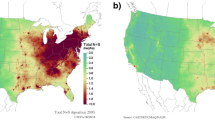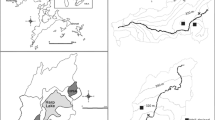Abstract
Changes in atmospheric deposition, stream water chemistry, and solute fluxes were assessed across 15 small forested catchments. Dramatic changes in atmospheric deposition have occurred over the last three decades, including a 70% reduction in sulphur (S) deposition. These changes in atmospheric inputs have been associated with expected changes in levels of acidity, sulphate and base cations in streams. Soil retention of S appeared to partially explain rates of chemical recovery. In addition to these changes in acid–base chemistry we also observed unexpected changes in nitrogen (N) biogeochemistry and nutrient stoichiometry of stream water, including decreased stream N concentrations. Among all catchments the average flux of dissolved inorganic nitrogen (DIN) was best predicted by average runoff, soil chemistry (forest floor C/N) and levels of acid deposition (both S and N). The rate of change in stream DIN flux, however, was much more closely correlated with reductions in rates of S deposition rather than those of DIN. Unlike DIN fluxes, the average concentrations as well as the rates of decline in streamwater nitrate (NO3) concentration over time were tightly linked to stream dissolved organic carbon/dissolved organic nitrogen ratios DOC/DON and DON/TP rather than catchment characteristics. Declines in phosphorus adsorption with increasing soil pH appear to contribute to the relationship between C, N, and P in our study catchments. Our observations suggest that catchment P availability and its alteration due to environmental changes (e.g. acidification) might have profound effects on N cycling and catchment N retention that have been largely unrecognized.







Similar content being viewed by others
References
Aitkenhead JA, McDowell WH (2000) Soil C:N ratio as a predictor of annual riverine DOC flux at local and global scales. Glob Biogeochem Cycles 14:127–138. doi:10.1029/1999GB900083
Balestrini R (2001) Atmospheric deposition and canopy exchange processes in alpine forest ecosystems (northern Italy). Atmos Environ 35:6421–6433. doi:10.1016/S1352-2310(01)00350-8
Borken W, Matzner E (2004) Nitrate leaching in forest soils: an analysis of long-term monitoring sites in Germany. J Plant Nutr Soil Sci 167:277–283. doi:10.1002/jpln.200421354
Dise NB, Matzner E, Forsius M (1998) Evaluation of organic horizon C:N ratio as an indicator of nitrate leaching in conifer forests across Europe. Environ Pollut 102:453–461
Draaijers GPJ, Erisman JW (1995) A canopy budget model to assess atmospheric deposition from throughfall measurements. Water Air Soil Pollut 85:2253–2258. doi:10.1007/BF01186169
Evans CD, Reynolds B, Jenkins A et al (2006) Evidence that soil carbon pool determines susceptibility of semi-natural ecosystems to elevated nitrogen leaching. Ecosystems 9:453–462. doi:10.1007/s10021-006-0051-z
Evans CD, Cooper DM, Monteith DT et al (2010) Linking monitoring and modelling: can long-term datasets be used more effectively as a basis for large-scale prediction? Biogeochemistry 101:211–227. doi:10.1007/s10533-010-9413-x
Evans CD, Monteith DT, Fowler D et al (2011) Hydrochloric acid: an overlooked driver of environmental change. Environ Sci Technol 45:1887–1894. doi:10.1021/es103574u
Fottová D, Skořepová I (1998) Changes in mass element fluxes and their importance for critical loads: GEOMON network, Czech Republic. Water Air Soil Pollut 105:365–376
Fuss CB, Driscoll CT, Campbell JL (2015) Recovery from chronic and snowmelt acidification: long-term trends in stream and soil water chemistry at the Hubbard Brook Experimental Forest, New Hampshire, USA. J Geophys Res Biogeosci 120:2360–2374. doi:10.1002/2015JG003063
Garmo ØA, Skjelkvåle BL, de Wit HA et al (2008) Trends in surface water chemistry in acidified areas in Europe and North America from 1990 to 2008. Water, Air, Soil Pollut 225:1880. doi:10.1007/s11270-014-1880-6
Goodale CL, Aber JD, Vitousek PM (2003) An unexpected nitrate decline in New Hampshire streams. Ecosystems 6:75–86. doi:10.1007/s10021-002-0219-0
Hofmeister J, Oulehle F, Krám P, Hruška J (2008) Loss of nutrients due to litter raking compared to the effect of acidic deposition in two spruce stands, Czech Republic. Biogeochemistry 88:139–151. doi:10.1007/s10533-008-9201-z
Horecký J, Rucki J, Krám P et al (2013) Differences in benthic macroinvertebrate structure of headwater streams with extreme hydrochemistry. Biologia 68:303–313. doi:10.2478/s11756-013-0156-8
Hruška J, Krám P (2003) Modelling long-term changes in stream water and soil chemistry in catchments with contrasting vulnerability to acidification (Lysina and Pluhuv Bor, Czech Republic). Hydrol Earth Syst Sci 7:525–539
Hruška J, Krám P, McDowell WH et al (2009) Increased dissolved organic carbon (DOC) in Central European streams is driven by reductions in ionic strength rather than climate change or decreasing acidity. Environ Sci Technol 43:4320–4326. doi:10.1021/es803645w
Hruška J, Krám P, Moldan F et al (2014) Changes in soil dissolved organic carbon affect reconstructed history and projected future trends in surface water acidification. Water Air Soil Pollut 225:2015. doi:10.1007/s11270-014-2015-9
Hruška J, Moldan F, Krám P (2002) Recovery from acidification in Central Europe—observed and predicted changes of soil and streamwater chemistry in the Lysina catchment, Czech Republic. Environ Pollut 120:261–274
Johnson AH, Siccama TG (1983) Acid deposition and forest decline. Environ Sci Technol 17:294–305
Juang FHT, Johnson NM (1967) Cycling of chlorine through a forested catchment in New England. J Geophys Res 72:5641–5647
Kolář T, Čermák P, Oulehle F et al (2015) Pollution control enhanced spruce growth in the “Black Triangle” near the Czech-Polish border. Sci Total Environ 538:703–711. doi:10.1016/j.scitotenv.2015.08.105
Kopáček J, Stuchlík E, Fott J et al (1998) Reversibility of acidification of mountain lakes after reduction in nitrogen and sulphur emissions in central Europe. Limnol Oceanogr 43:357–361
Kopáček J, Turek J, Hejzlar J et al (2006a) Element fluxes in catchment-lake ecosystems recovering from acidification: Plešné Lake, the Bohemian Forest, 2001–2005. Biologia 61:S427–S440
Kopáček J, Turek J, Hejzlar J et al (2006b) Element fluxes in catchment-lake ecosystems recovering from acidification: Čertovo Lake, the Bohemian Forest, 2001–2005. Biologia 61:S413–S426. doi:10.2478/s11756-007-0066-8
Kopáček J, Turek J, Hejzlar J, Šantrůčková H (2009) Canopy leaching of nutrients and metals in a mountain spruce forest. Atmos Environ 43:5443–5453. doi:10.1016/j.atmosenv.2009.07.031
Kopáček J, Posch M, Hejzlar J et al (2012) An elevation-based regional model for interpolating sulphur and nitrogen deposition. Atmos Environ 50:287–296. doi:10.1016/j.atmosenv.2011.12.017
Kopáček J, Cosby BJ, Evans CD et al (2013) Nitrogen, organic carbon and sulphur cycling in terrestrial ecosystems: linking nitrogen saturation to carbon limitation of soil microbial processes. Biogeochemistry 115:33–51. doi:10.1007/s10533-013-9892-7
Kopáček J, Bičárová S, Hejzlar J et al (2015a) Catchment biogeochemistry modifies long-term effects of acidic deposition on chemistry of mountain lakes. Biogeochemistry 125:315–335. doi:10.1007/s10533-015-0127-y
Kopáček J, Hejzlar J, Kaňa J et al (2015b) Effects of acidic deposition on in-lake phosphorus availability: a lesson from lakes recovering from acidification. Environ Sci Technol 49:2895–2903. doi:10.1021/es5058743
Kopáček J, Hejzlar J, Krám P et al (2016) Effect of industrial dust on precipitation chemistry in the Czech Republic (Central Europe) from 1850 to 2013. Water Res 103:30–37. doi:10.1016/j.watres.2016.07.017
Krám P, Hruška J, Driscoll CT et al (2009a) Long-term changes in aluminum fractions of drainage waters in two forest catchments with contrasting lithology. J Inorg Biochem 103:1465–1472. doi:10.1016/j.jinorgbio.2009.07.025
Krám P, Oulehle F, Štědrá V et al (2009b) Geoecology of a forest catchment underlain by serpentine in Central Europe. Northeast Nat 16:309–328. doi:10.1656/045.016.0523
Krám P, Hruška J, Shanley JB (2012) Streamwater chemistry in three contrasting monolithologic Czech catchments. Appl Geochem 27:1854–1863. doi:10.1016/j.apgeochem.2012.02.020
Lamačová A, Hruška J, Krám P et al (2014) Runoff trends analysis and future projections of hydrological patterns in small forested catchments. Soil Water Res 9:169–181
Larssen T, Carmichael GR (2000) Acid rain and acidification in China: the importance of base cation deposition. Environ Pollut 110:89–102
Lovett GM, Lindberg SE (1993) Atmospheric deposition and canopy interactions of nitrogen in forests. Can J For Res Can Rech For 23:1603–1616
Lovett GM, Weathers KC, Arthur MA (2002) Control of nitrogen loss from forested catchments by soil carbon:nitrogen ratio and tree species composition. Ecosystems 5:712–718. doi:10.1007/s10021-002-0153-1
Lovett GM, Likens GE, Buso DC et al (2005) The biogeochemistry of chlorine at Hubbard Brook, New Hampshire, USA. Biogeochemistry 72:191–232. doi:10.1007/s10533-004-0357-x
Monteith DT, Stoddard JL, Evans CD et al (2007) Dissolved organic carbon trends resulting from changes in atmospheric deposition chemistry. Nature 450:537. doi:10.1038/Nature06316
Monteith DT, Evans CD, Henrys PA et al (2014) Trends in the hydrochemistry of acid-sensitive surface waters in the UK 1988–2008. Ecol Indic 37:287–303. doi:10.1016/j.ecolind.2012.08.013
Navrátil T, Kurz D, Krám P et al (2007) Acidification and recovery of soil at a heavily impacted forest catchment (Lysina, Czech Republic)—SAFE modeling and field results. Ecol Model 205:464–474. doi:10.1016/j.ecolmodel.2007.03.008
Novák M, Kirchner JW, Fottová D et al (2005) Isotopic evidence for processes of sulphur retention/release in 13 forested catchments spanning a strong pollution gradient (Czech Republic, central Europe). Global Biogeochem Cycles. doi:Gb401210.1029/2004gb002396
Oberg G, Sanden P (2005) Retention of chloride in soil and cycling of organic matter-bound chlorine. Hydrol Process 19:2123–2136. doi:10.1002/hyp.5680
Oulehle F, McDowell WH, Aitkenhead-Peterson JA et al (2008) Long-term trends in stream nitrate concentrations and losses across catchments undergoing recovery from acidification in the Czech Republic. Ecosystems 11:410–425. doi:10.1007/s10021-008-9130-7
Oulehle F, Chuman T, Majer V, Hruška J (2013) Chemical recovery of acidified Bohemian lakes between 1984 and 2012: the role of acid deposition and bark beetle induced forest disturbance. Biogeochemistry. doi:10.1007/s10533-013-9865-x
Riofrío-Dillon G, Bertrand R, Gégout J-C (2012) Toward a recovery time: forest herbs insight related to anthropogenic acidification. Glob Chang Biol 18:3383–3394. doi:10.1111/gcb.12002
Rose R, Monteith DT, Henrys P et al (2016) Evidence for increases in vegetation species richness across UK environmental change network sites linked to changes in air pollution and weather patterns. Ecol Indic. doi:10.1016/j.ecolind.2016.01.005
Smith SJ, van Aardenne J, Klimont Z et al (2011) Anthropogenic sulphur dioxide emissions: 1850–2005. Atmos Chem Phys 11:1101–1116. doi:10.5194/acp-11-1101-2011
Sterner RW, Elser JJ (2002) Ecological stoichiometry: the biology of elements from molecules to the biosphere. Princeton University Press, Princeton
Stoddard JL, Jeffries DS, Lükewille A et al (1999) Regional trends in aquatic recovery from acidification in North America and Europe 1980–95. Nature 401:575–578
Stoddard JL, Van Sickle J, Herlihy AT et al (2016) Continental-scale increase in lake and stream phosphorus: Are oligotrophic systems disappearing in the United States? Environ Sci Technol 50:3409–3415. doi:10.1021/acs.est.5b05950
Strock KE, Nelson SJ, Kahl JS et al (2014) Decadal trends reveal recent acceleration in the rate of recovery from acidification in the northeastern U.S. Environ Sci Technol 48:4681–4689. doi:10.1021/es404772n
Svensson T, Lovett GM, Likens GE (2011) Is chloride a conservative ion in forest ecosystems? Biogeochemistry. doi:10.1007/s10533-010-9538-y
Taylor PG, Townsend AR (2010) Stoichiometric control of organic carbon–nitrate relationships from soils to the sea. Nature 464:1178–1181. doi:10.1038/nature08985
Traister EM, McDowell WH, Krám P et al (2013) Persistent effects of acidification on stream ecosystem structure and function. Freshw Sci 32:586–596
Vestreng V, Myhre G, Fagerli H et al (2007) Twenty-five years of continuous sulphur dioxide emission reduction in Europe. Atmos Chem Phys 7:3663–3681
Vitousek PM, Porder S, Houlton BZ, Chadwick OA (2010) Terrestrial phosphorus limitation: mechanisms, implications, and nitrogen–phosphorus interactions. Ecol Appl 20:5–15. doi:10.1890/08-0127.1
Vrba J, Bojková J, Chvojka P et al (2016) Constraints on the biological recovery of the Bohemian Forest lakes from acid stress. Freshw Biol 61:376–395. doi:10.1111/fwb.12714
Acknowledgements
Filip Oulehle acknowledges the Czech Science Foundation (CSF) Grant no. 14-33311S. Further support was provided by the People Programme (Marie Curie Actions) of the EU 7FP under REA Grant agreement no. PCIG13-GA-2013-618430. Jakub Hruška acknowledges CSF Grant no. 15-08124S. The GEOMON monitoring program was recently supported by the Grant from Iceland, Liechtenstein and Norway “Monitoring of small forested catchments GEOMON— research tool for strategic policy decisions in the environment” (EHP-CZ02-OV-1-048-2014). William H. McDowell acknowledges partial support from the New Hampshire Agricultural Experiment Station. This is Scientific Contribution number 2708. This work was supported by the USDA National Institute of Food and Agriculture (McIntire-Stennis); Project Accession Number 1006760.
Author information
Authors and Affiliations
Corresponding author
Additional information
Responsible Editor: Jacques C. Finlay.
Electronic supplementary material
Below is the link to the electronic supplementary material.
Rights and permissions
About this article
Cite this article
Oulehle, F., Chuman, T., Hruška, J. et al. Recovery from acidification alters concentrations and fluxes of solutes from Czech catchments. Biogeochemistry 132, 251–272 (2017). https://doi.org/10.1007/s10533-017-0298-9
Received:
Accepted:
Published:
Issue Date:
DOI: https://doi.org/10.1007/s10533-017-0298-9




